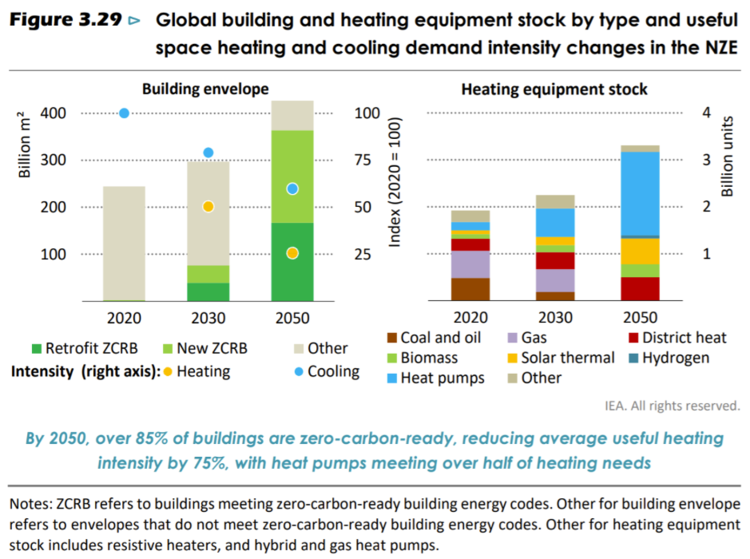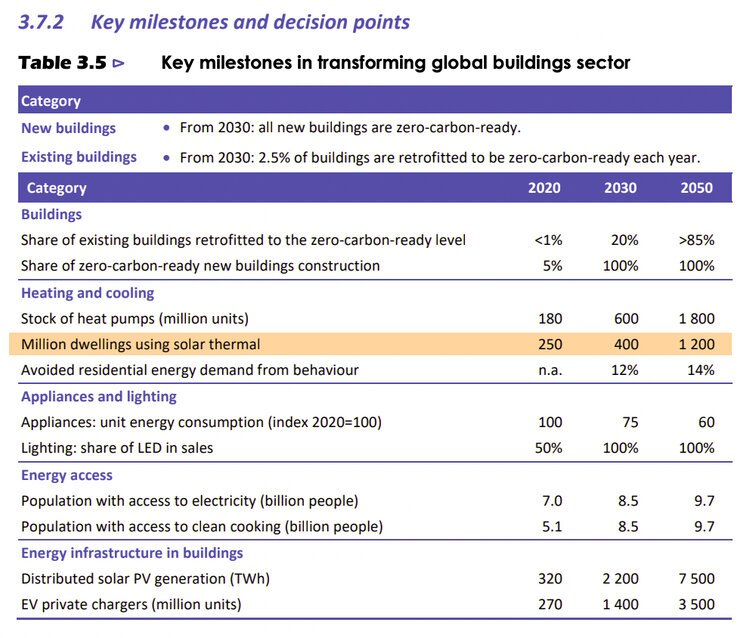Is the world clocking on to solar thermal?
Solar thermal finally seems to be receiving the good press it deserves, thanks to the ambitious targets set out in the IEA’s report: Net Zero by 2050 - A Roadmap for the Global Energy Sector. We are excited by the recent value placed on solar thermal and can’t wait to see how it will contribute to the decarbonisation of heat globally.
The IEA’s projections show renewables, including solar thermal, as key to the transition away from fossil fuelled gas boilers. The integration of renewables will be increasingly important to achieve net zero affordably in the residential sector, in addition to other carbon intensive heat applications in manufacturing, food & beverage, hospitality, and the public sector. The UK has already introduced a gas boiler ban in 2025, a statement that is mirrored across Europe and beyond.
“The direct use of renewable energy rises from about 10% of heating demand globally in 2020 to 40% in 2050, about three-quarters of the increase is in the form of solar thermal and geothermal.”
— IEA REPORT, P.74
Like the IEA, we envisage a future where everything from our homes to hotels are heated by alternative means to fossil fuels. Electrification, particularly in the form of heat pumps, will be a key part of the decarbonisation roadmap. However, with the IEA projecting renewable resources to account for 88% of electricity generation by 2050, solar thermal, as an off-grid, on-site, distributed technology will contribute to supply without putting further pressure on the grid.
It’s fair to say that historically, solar thermal has been a little overlooked and underestimated and we are proud to contribute to the reinvention of tried and tested technologies. Our Virtu solar collector was recently acknowledged by CIBSE for its thermal innovation and industry support is growing exponentially: we feel that solar thermal is finally getting the recognition it deserves.
Life after gas
The banning of gas boilers globally by 2025, set out in the IEA trajectory, creates a need for the integration of heat generating alternatives, such as solar thermal, in the next 5 years. Using appropriate and available technology is critical to the transition to net zero and to keep the ‘business as usual’ sign on the door.
Our hybrid solar thermal collector VirtuPVT is the world's highest energy density solar technology, simultaneously producing heat and power from a given area, and producing 3x the carbon savings compared to conventional solar PV. With their tubular design, integrated reflectors and low profile, Virtu avoids self-shading and captures 40% more of the sun’s energy than PV, delivering a greater impact for the same roof area. What’s more, it is possible to rotate the absorber angle such that supply is optimised during shoulder months.
The best part is that Virtu is available now, making it critical to the immediate reduction of emissions from water and space heating in buildings.
Virtu is suitable for a range of applications where there is a high heat (space and water) demand all year round. Whilst a city-based hotel might place Virtu solar thermal collectors on the façade of the building and on the roof, a residential developer could integrate solar thermal with heat pumps or a district heating network, involving a ground-mounted array. Versatile, right?
Cost effective heat
The IEA describes solar thermal as the “preferred renewable technology for water heating”, addressing 35% of water heating demand by 2050, 28% more than today. Our solar thermal collectors are designed to address hot water demand, sustainably transforming a warm day into the hot water demands of your hot shower or manufacturing process heat.
Heat storage in water tanks is highlighted as “generally more cost‐effective than storage of electricity” by the IEA. Inter-seasonal storage innovations make it increasingly possible to utilise the variability of solar supply, improving the reliability of this resource.
Deep-retrofits and energy related building codes
The IEA predicts that “almost all buildings with available roof space and sufficient solar insolation are equipped with solar thermal water heaters by 2050”.
“Whenever possible, new and existing zero‐carbon‐ready buildings should integrate locally available renewable resources, e.g. solar thermal, solar PV, PV thermal and geothermal, to reduce the need for utility‐scale energy supply.”
— IEA REPORT, P.144
The beauty of solar thermal, and particularly our Virtu tubes, lies in their versatile design and compatibility with a range of buildings and demand requirements. They are well suited to address net-zero requirements at a country or city level, whether for new builds or retrofits. The compact, modular design of the tubes and self-ballasting structure takes up half of the space and installation costs of solar PV, but with more energy generated. With VirtuPVT providing both heat and power from a given space, it’s is a win-win scenario and a valuable asset to tackle the decarbonisation of tricky Scope 1 and Scope 2 emissions.
Solar thermal and industry demand
Alongside geothermal energy, solar thermal will address 15% of industry heat demand in 2030 and 40% in 2050. Our VirtuHot collector can reach temperatures of 120 degrees, making it a great source of heat for industry applications, such as sterilasation needed in food and beverage manufacturing.
Gaining traction
The IEA are not alone in their call to action for a just, low carbon transition of the energy sector. It is evident that more needs to be done. Carbon emissions have continued to increase, even as the number of net zero commitments (from corporates and countries) has skyrocketed.
We’re expecting some of the big players in carbon intensive industries to come forward with more detailed plans on how they’ll achieve their pledges to reach net zero carbon emissions, or even carbon positive - some as early as 2030.
Solarthermalworld recently put IKEA in the spotlight (read article here), who are investing 4 billion euros in a“transition to a renewable energy future”. A remarkable commitment to decarbonise their buildings, manufacturing and entire supply chain.
As the world catches on to the benifits of solar thermal, we are expecting to see many of these leading, innovative brands like IKEA turn towards the sun. Especially when the possibilities of Virtu technology become widely recognised! After all, the sun is an infinite source of clean energy.
How will you decarbonise your organisation’s heat demand?
Get in touch with our technical team for more information on Virtu and the opportunities to reduce your heat emissions today.



